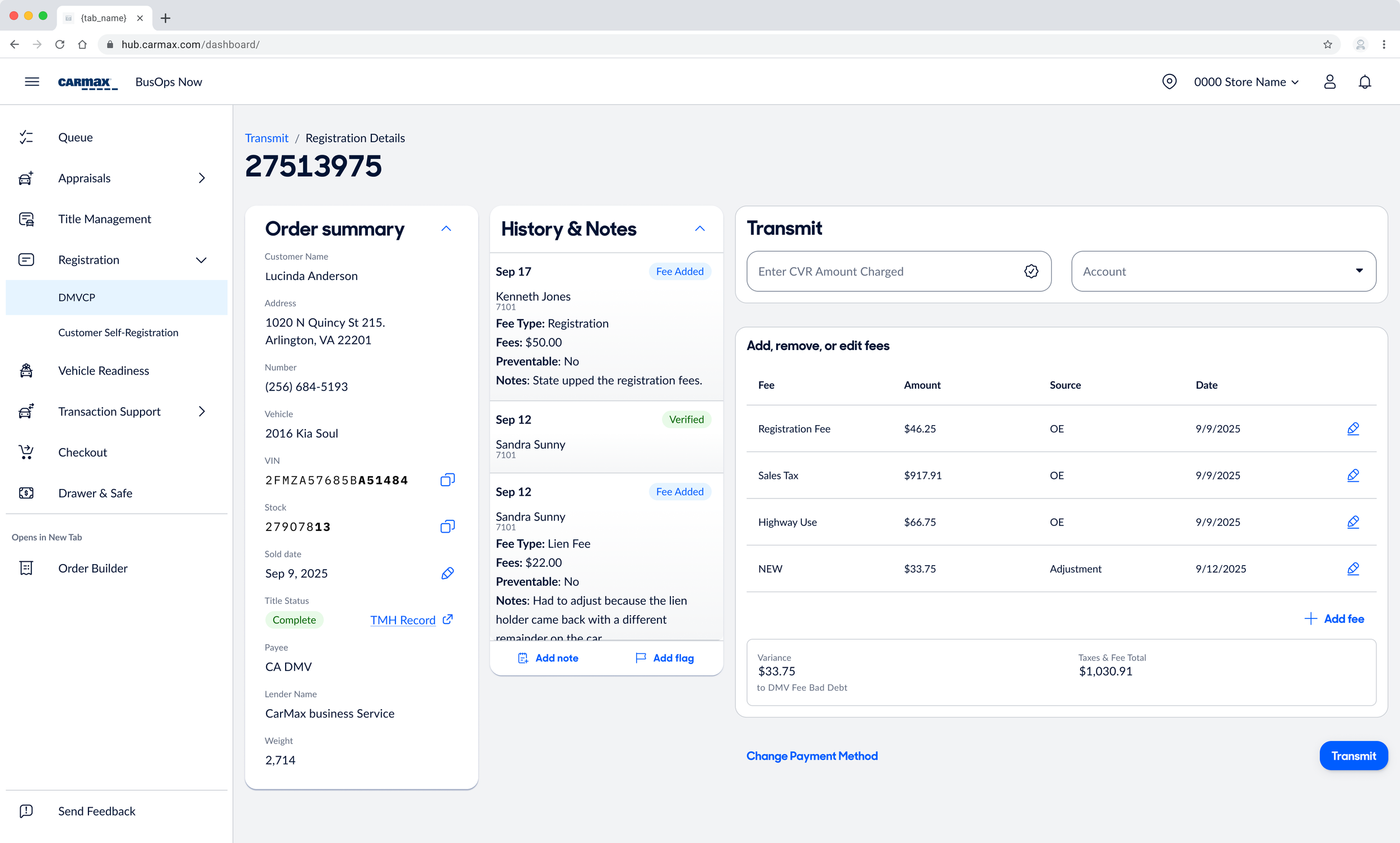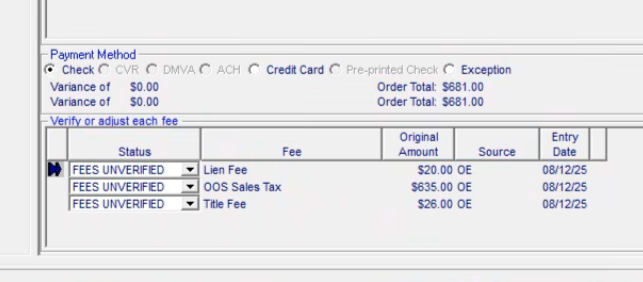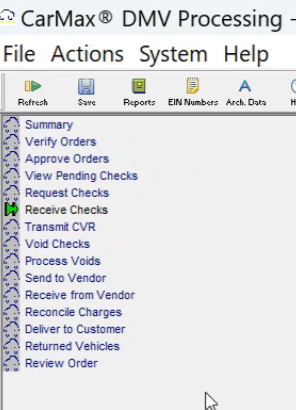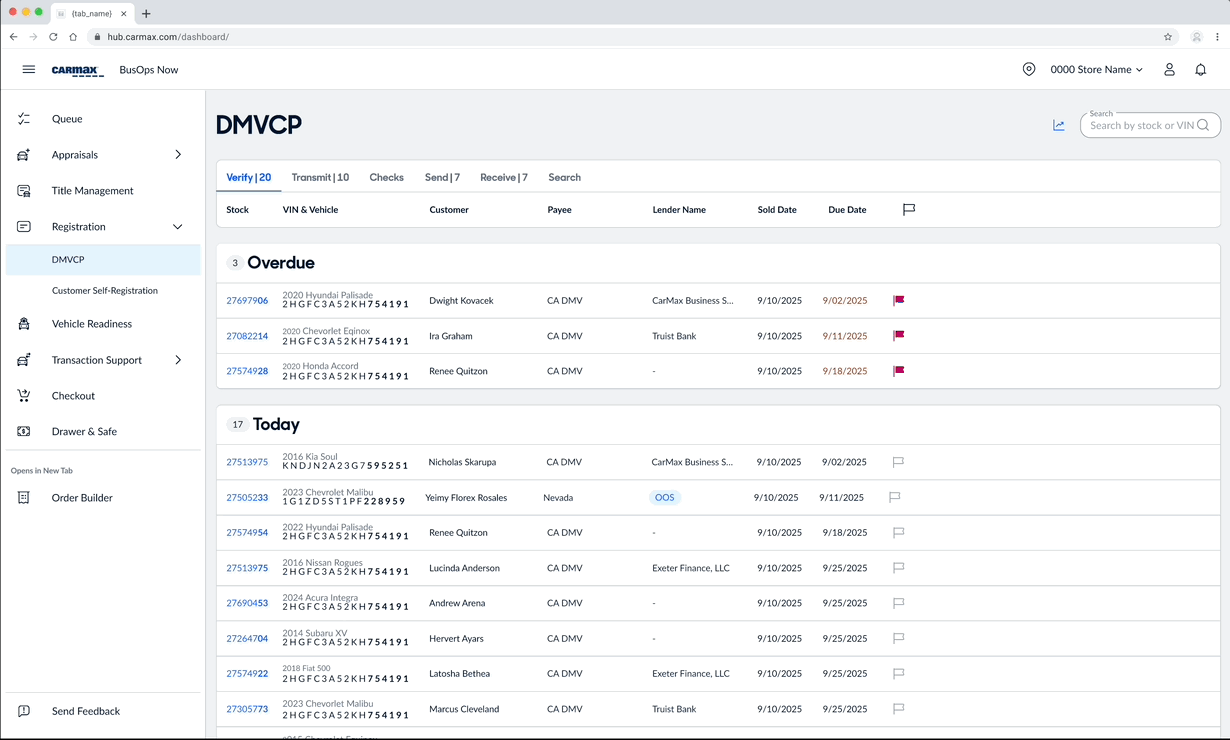C A R M A X
Redesigning DMVCP
Six Weeks to Transform a Legacy System Nobody Wanted to Touch
For years, CarMax business office associates had been fighting with the DMVCP (Department of Motor Vehicle Check Processing) system built in PowerBuilder that felt like it belonged in a museum. Every day, these associates were responsible for getting customers' vehicles legally registered, which meant processing paperwork and payments to DMVs across different states. The stakes were high: mistakes meant accounting errors, delayed registrations, and frustrated customers.
The legacy system was actively working against them. It was slow, didn't work in real-time, and required associates to do manual calculations that the system should have handled. Even worse, out-of-state registration work had been moved to a modern tool, forcing associates to split their attention across platforms. The training required to use DMVCP was extensive, and even then, accounting errors happened with alarming frequency.
When CarMax decided to tackle this problem, they didn't opt for a typical 18-month development cycle. Instead, they created a six-week "Rapid Action Development" team & asked: could we actually fix this?
The Journey
-
The RAD team structure was intentionally lean: a product manager, backend engineer, frontend engineer, quality engineer, a field lead to connect us with store associates, and me as the product designer. We were pulled from our regular teams and given permission to ignore other company responsibilities. This was rare—total focus, total dedication. We also received AI resources, though they ended up being more hype than help.
Six weeks. That was our constraint, our challenge, and honestly, our excuse to move fast and break the usual rules.
-
The research phase had to be aggressive. I conducted generative interviews across different states because DMV requirements vary wildly—what works in California doesn't work in Virginia. One in-person trip, followed by eight video calls in week two, gave me the foundation I needed.
What I heard was pain. Real, visceral frustration. Associates described the old system with the kind of exhaustion that comes from fighting broken tools every single day. But I also heard something surprising: when I showed operational partners ways we could remove unnecessary steps, they were eager to simplify. I'd expected pushback, bureaucratic resistance. Instead, I found allies who were just as tired of the complexity as the frontline associates.
The validation came through emotion. When associates saw early prototypes during our four usability testing calls, their relief was palpable. One associate literally said she wanted to cry—in a good way. That kind of reaction tells you everything about how badly the old system was failing.
-
Here's where things got chaotic in the best and worst ways.
I worked in Figma during the interviews. Not after—during. I'd be on a call, listening to an associate walk through their workflow, and I'd be adjusting the prototype in real-time. The moment the call ended, I'd huddle with the team to iterate before the next round of calls started.
This approach was exhilarating and exhausting. We called it "echo exhaustion"—trying to rapidly incorporate new learnings into prototypes led to overwhelming fatigue. I shifted to extreme working schedules and burned out early. The continuous pressure from company demands, combined with being isolated from other teams, meant key decisions were being made without the usual collaborative dialogue.
What I'd do differently: At the start, we should have created a shared playbook outlining work preferences and necessary focus times. We recorded meetings but full transcriptions proved minimally useful. We made the right call avoiding AI for prototyping—our existing design frameworks (CarMax's Material UI and Associate Tool Framework) were sufficient, and AI would have just added documentation overhead for developers.
I leaned heavily on principles that kept me grounded: "Design like you're right, test like you're wrong." And I thought beyond the six-week timeline, focusing on how this project would connect to the larger ecosystem and persist into the future. Less is more became my mantra when facing feature creep.
What we actually built
The transformation was significant. We took a system that required extensive training and turned it into something intuitive.
Eliminates the tedious stuff:
Collects total fees and highlights the variance removing the need for manual math.
Auto-creates notes when fees or status change, eliminating manual data entry
Determines correct transmission days per state automatically
Requests checks on behalf of associates after verification, reducing a full step
Streamlined the workflow:
Consolidates scattered queues into clean progressive tabs
Allows customer to see all notes & history in a single view instead of multiple windows
Opens each record individually as a full page window for clear task focus
Removed manager approval bottlenecks for verification and voiding checks
Made data actually useful:
Integrated title status directly in DMVCP
Clear labeling of work priority (Today vs. Overdue vs. Upcoming)
Better tracking of why records are flagged or stuck
Laid groundwork for future Oracle integration to show check status
Prevented errors before they happened:
Created a "resolution" queue to prevent records from bouncing backward through stages
Pre-flagged rejected records with specific reasons
New "Send to Vendor" process to track all physical paperwork with bulk sending capabilities
Thinking back
-
We didn't build the entire product in six weeks—that was never realistic, though I wish I'd communicated that expectation more clearly to stakeholders upfront. What we did deliver was complete UX work, a functional prototype, and development cards ready to scale nationwide.
Without time for quantitative research, we relied entirely on qualitative feedback. The evidence was clear in the ease of support requests and overwhelmingly positive feedback from associates. One field partner told us this was the smoothest rollout she'd experienced in years.
-
About users: They'll forgive imperfect solutions if you solve their real pain. Associates didn't need a perfect system; they needed one that worked with them instead of against them.
About process: Rapid timelines require complete team dedication and senior roles that facilitate alignment and trust. Our team worked because everyone was all-in. But the burnout was real, and there's a cost to that velocity that companies often underestimate.
About myself: I can design under intense pressure, but I need to advocate harder for sustainable pacing. The best work happens when there's room to breathe between sprints of intensity.
About collaboration: Leadership encouraged comprehensive discovery until I could articulate job requirements in customers' own words. That patience—even in a sprint—made all the difference. More dialogue at the beginning prevents misunderstandings later.
-
We accomplished what we did because of deep domain knowledge and pattern recognition. My experience in CarMax's title space and with frontend patterns from other tools I'd designed proved to be the perfect fit for DMVCP's challenges. I wasn't starting from zero—I was building on years of understanding how these associates actually work.
The global search feature sets the foundation for potential centralization of DMVCP work across stores. Any store can now look up records and help customers, reducing the need to transfer frustrated people between locations. It's a small feature that unlocks big possibilities.






What's Next
The lingering challenge is integration. We've modernized one piece, but the vision of bringing in-state and out-of-state registration work together under one roof is still ahead. The system we built is designed to accommodate state-by-state rule variations and prepare for future self-registration tracking. We laid the foundation; now it needs to scale.
The Bottom Line: We transformed DMVCP from a complex, error-prone system requiring extensive training into an intuitive tool that guides associates through the right work at the right time. We did it in six weeks. We burned out doing it. And honestly? I'd do it again—just with better boundaries and clearer stakeholder communication from day one.












